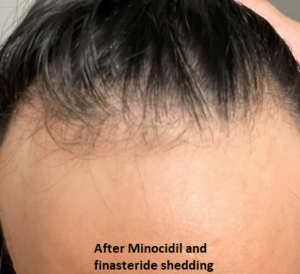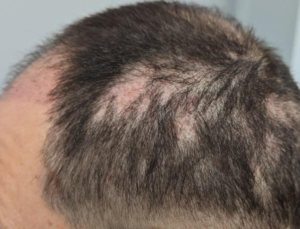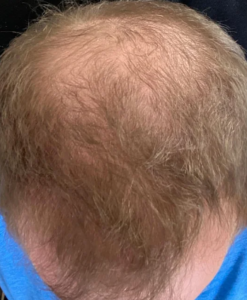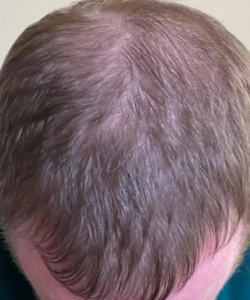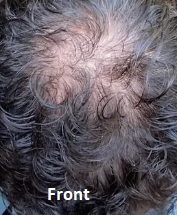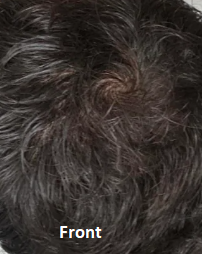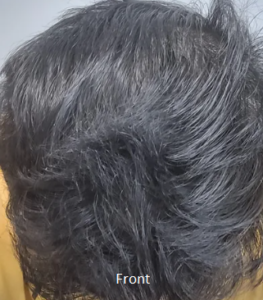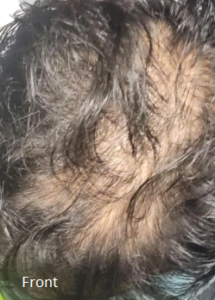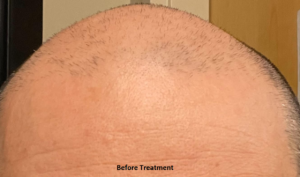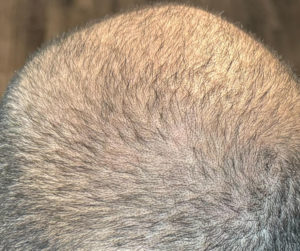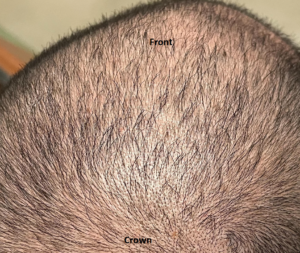This man had a hair transplant a few weeks before these bald spots appeared on his head. More and more of them appeared. To make the diagnosis, a biopsy needs to be done. It is likely a scarring alopecia, but it could be a variety of scalp/hair diseases triggered by the hair transplant. I have seen men who never had alopecia areata, then get a hair transplant, and alopecia areata appears from days to weeks after the transplant. A surgeon must have a keen eye and perform a good trichoscopic examination on the head of all of his patients before the surgery. As a surgeon, I don’t like surprises, and I am sure that you, as a patient, wouldn’t like them either.
hey dr, your patient that take oral minoxidil do they develop unwanted hair on back- shoulder or upper cheek? thanks
Every person responds differently. Some get more body hair, and some don’t.
My dermatologist recommended that I should give oral minoxidil a try now, but I’m concerned about the generalized effect it will have on hair growth. I am generally quite happy with my low body hair level and would like to avoid getting a unibrow and super hairy arms and legs. Could some people share their experience with hypertrichosis while on oral minoxidil?
If you start on it and develop hair growth side effects that you don’t like, stop the medication, and the hair side effects will go away. Hair growth from minoxidil is heavily dependent upon taking the minoxidil and my stopping the drug, the unwanted hair will disappear.
I started using a higher dose of topical finasteride about a month ago and ever since then I have been noticing more hairloss. I do know the so-called “finasteride shed” (initial period where hairloss temporarily increases) but I am surprised that it started literally the day after my first application (I thought it should take some time to start working). I have been monitoring the amount of my hairloss (after washing my hair) for months and nowadays I see about twice as much hair in the bathtub than before. I know that this is probably happening due to finasteride and that it should be a good sign but a part of me still worries that it might be just my hairloss getting more aggressive.Could you please advise me on how long the increased shedding period should approximately last
Finasteride shed should stop within another month or so. It rarely lasts more than 3 months, and if it approaches 3 months, it may be your balding is accelerating and the finasteride is not stopping it. Will will know which one it is by month 4.
I’d say 90% of the hairs I’m shedding are miniaturized. I still have a head of hair but it’s gotten a lot thinner. I’m shedding like crazy mostly mini hairs. But still have new growth at my hair line. 2.5 years on fin topical minox everyday 2x
A normal male without genetic hair loss sheds 100-150 hairs daily. For a balding man, the shed of miniaturized hairs adds to that volume. The 100-150 new ‘terminal’ hairs will replace themselves with another hair somewhere. Still, the miniaturized hairs are likely the end stage for that hair and rarely come back unless stimulated by finasteride or microneedling. If you have been consistently on finasteride without stopping it and shedding now, that is an ominous sign that your hair loss is accelerating. If you stopped the finasteride and just restarted it, the shed would indicate that the drug is working.
I’ve recently switched from using liquid Minoxidil to the foam version, and I’ve noticed a few differences. The foam leaves my hair less greasy, which is a plus, and it’s also reduced the itchiness on my scalp, which I’m happy about. However, I’ve been wondering if the reduced itchiness means that less Minoxidil is getting absorbed into my scalp. Also, I find it a bit more challenging to get the foam directly onto my scalp compared to the liquid.
I’d really appreciate any insights or advice from those who have made a similar switch or have experience with the foam version. Thanks!
Minoxidil works in only 40% of men because the remaining 60% do not have the enzyme in the scalp to convert minoxidil into minoxidil sulfate, the active for of the drug that brings on the hair. The pill, on the other hand, works on all men because the liver converts the minoxidil into its active form. The liquid is better than the foam because you can get it on the scalp where it belongs, while too much foam goes on the hair, which does little good. The goal for the topical minoxidil is to get it on the scalp not the hair.
My comments are as follows:
- He has a risk of developing necrosis on the scalp recipient and donor areas. The look immediately after surgery doesn’t tell much about what it will look like in just a few days.
- This man almost certainly will have balding on the side and back of his head at the donor area in most men will not support 6100 grafts and leave enough hair for coverage purposes.
- I wonder how many of these grafts will actually grow
Somehow, either the Black Market folks who did this surgery or the patient thought that these large numbers of grafts would create a great head of hair. I would be surprised if it did.
Out of curiosity, why do some men wait until they are in quite an advanced stage of male pattern baldness before they decide to do anything about it? Do you think it’s primarily down to fear over conventional treatments (e.g. finasteride side-effects), or do you think it’s just a failure to be proactive and not dealing with the problem until it’s staring them in the face? I’m of the opinion that the most effective way to combat male pattern baldness is to get on finasteride at the earliest sign of recession or diffuse thinning, but this doesn’t seem to be all that common.
This is a great question. Men exercise denial much of the time with their hair. That denial sometimes lasts into old age, as seen by combovers (https://baldingblog.com/wp-admin/post.php?post=36158&action=edit). We have seen many forms of Combovers, clearly starting early in the balding process. When I initially saw these men, I wondered if they saw what I saw and how ridiculous it looked, but then I realized that they never saw the change over the years. Some young men are more observant and willing to address balding early in their lives. Some men 16-18 may even be overly concerned, But at least they are aware of the possibilities, possibly because someone in their family has advanced balding, and they held this fear early in their life. Today’s facts of life (concerning hair, that is), is that if a man picks it up early, they can ALWAYS slow or stop it, possibly even reverse it. Denial is the enemy here.
I have been on topical for a year and got the approval to switch to oral minoxidil. Should I expect shedding? Anything else?
My patients who switched did not report shedding to me, as I advised them to stop taking the topical when they went on the oral minoxidil.
To the people that affirm high DHT in the scalp is not a cause but consequence of AGA, why does lowering it throught medication seem to give positive results in most men?
The genes for hair loss are in both men and women; however, men produce significantly more testosterone than women. The testosterone is metabolized into DHT and DHT works on the genetically impacted hair follicle to cause loss. Finasteride blocks 70% of the activity of DHT on the hair follicle receptors, so it works well. If you gave a woman the amount of testosterone that a man makes daily, and she had the genes for hair loss, she would go through something similar to what you are now going through. The older she is, the worse the hair loss would be for her, as it might be for you if you (and she) have inherited an advanced balding pattern. For premenopausal women, their Estrogen protects their hair from the DHT effect; however, when they pass menopause, they don’t have the estrogen protection and, therefore, might see hair loss, a common finding in ~50% of post-menopausal women.

